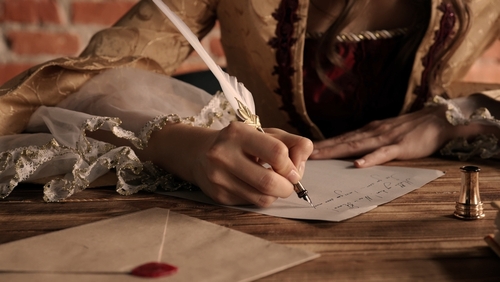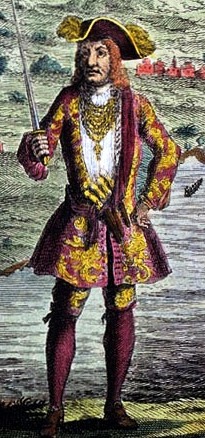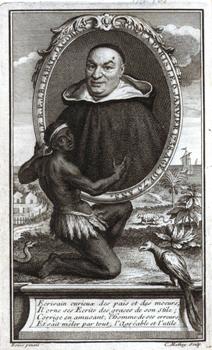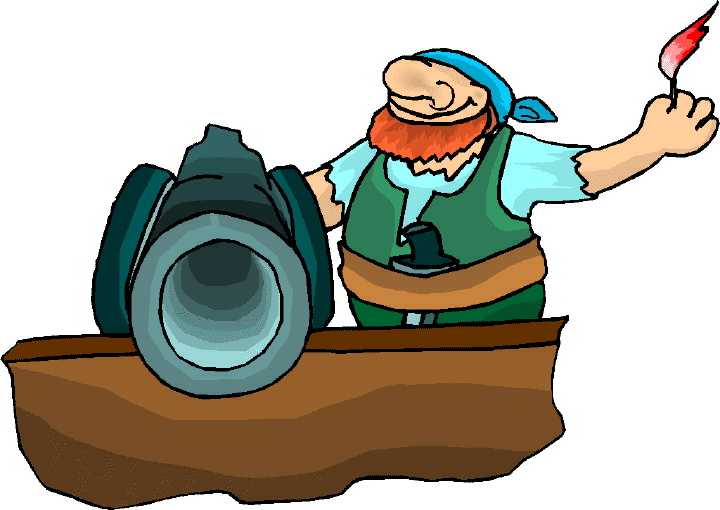 Pirates and Privateers Pirates and Privateers
The History of Maritime
Piracy
Cindy Vallar, Editor
& Reviewer
P.O. Box 425,
Keller, TX 76244-0425
    
In Memoriam
Eat, Drink, and Be Merry
by Cindy Vallar
 Being
a wordsmith, I often like to discover the origins of
a word or phrase. Pursuing this curiosity doesn’t
exactly provide me with a clear-cut answer, although
most sources agree that the roots of “eat, drink,
and be merry” can be found in the Bible. Except,
nowhere do those exact words appear. Being
a wordsmith, I often like to discover the origins of
a word or phrase. Pursuing this curiosity doesn’t
exactly provide me with a clear-cut answer, although
most sources agree that the roots of “eat, drink,
and be merry” can be found in the Bible. Except,
nowhere do those exact words appear.
And
behold ioy and gladnesse, slaying oxen and
killing sheep, eating flesh, and drinking wine;
let vs eate and drinke, for to morrow we
shall die. ~ Isaiah:
22:13, King James Bible (1611)
Then I commended mirth, because a man hath no
better thing vnder the Sunne, then to eate
and to drinke, and to be merrie: for that
shall abide with him of his labour, the days of
his life, which God giueth him vnder the Sunne.
~ Ecclesiastes 8:15, King James Bible (1611)
If after the maner of men I haue fought with
beasts at Ephesus, what aduantageth it me, if
the dead rise not? let vs eate and
drinke, for to morrow wee die.
~ 1 Corinthians 15:32, King James Bible (1611)
And I will say to my soule, Soule, thou has
much goods layd vp for many yeeres, take
thine ease, eate, drinke, and be merry. ~
Luke 12:19, King James Bible (1611)
Since the purpose of
this article concerns pirates and their daily lives,
I’m not going to expound on biblical teachings and
what any of these quotations mean. (That’s something
I invite you to discover on your own if desired.)
Instead, let me ask you, “Does the title of this
article, or any of these verse quotations bring to
mind the words alleged to have been pronounced by a
pirate?
Ah ,
I see I’ve sparked your curiosity. I’m fairly
certain you’ve figured out I refer to Bartholomew
Roberts’s oft-quoted words: ,
I see I’ve sparked your curiosity. I’m fairly
certain you’ve figured out I refer to Bartholomew
Roberts’s oft-quoted words:
No, a
merry Life and a short one, shall be my Motto.
This quote comes
from Captain Charles Johnson’s 1726 edition of A
General History of the Pyrates: “Thus he
preached himself into an Approbation of what he at
first abhorr’d; and being daily regal’d with Musick,
Drinking, and the Gaiety and Diversions of his
Companions, these deprav’d Propensities were quickly
edg’d and strengthened, to the extinguishing of Fear
and Conscience.” (Defoe, 244)
If you notice, I said the words are allegedly those
of Roberts. With Johnson, you should always check
from one edition to another because they aren’t the
same. In the first edition, which was published two
years earlier, the quotation doesn’t exist. Instead,
the pirate often drank “D—n to him who ever lived
to wear a Halter.” (Johnson, 213-214)
Despite this discrepancy as to whether Roberts
believed pirates should eat, drink, and be merry, he
understood that having chosen this wayward path,
there was a chance he would die young. (Between 1653
and 1728, a person might live between twenty-five
and thirty-seven years on average.) The simple fact
was, life was short for many people. Plus,
it was often safer to drink alcohol than water. To a
pirate, wasn’t it better to be merry and cheerful
than sad and gloomy? So how did pirates have fun,
especially during the holidays?

How the average person celebrated Christmas depended
on their location, religion, and the law. The
leaders of the Massachusetts Bay Colony passed a law
in 1659, that set a fine of five shillings on anyone
who chose to be idle, have a feast, or celebrate
“any such day as Christmas or the like.” (Pruitt) In
England and many of her colonies, it was common to
drink, party, and sing. These were the ways pirates
celebrated whatever occasion they deemed worth
observing, but only a few left accounts of how they
marked special days.
 One of the earliest
records of a special observance came from Père
Jean-Baptiste Labat, a French missionary who
found himself the guest of buccaneers. (English
translation) Capitaine Daniel wanted
him to say mass aboard their barque in March 1694. One of the earliest
records of a special observance came from Père
Jean-Baptiste Labat, a French missionary who
found himself the guest of buccaneers. (English
translation) Capitaine Daniel wanted
him to say mass aboard their barque in March 1694.
They
sent for the church ornaments, and put up an
altar on the poop under an awning, and then
chanted Mass lustily. A salvo of eight cannons
marked the commencement of the service, they
fired a second salvo at the Sanctus, and third
at the Elevation, a fourth at the Benediction,
and lastly a fifth after the Exaudiat, while the
prayer for the King was followed by the most
hearty “Vive le Roi”.
Only one
incident slightly marred this ceremony. One of
the pirates adopted an offensive attitude during
the Elevation, and on being rebuked by the
captain, he replied insolently with a horrible
oath. Daniel promptly drew his pistol and shot
him through the head and swore by God that he
would do the same to anyone else who showed
disrespect to the “Sainte Sacrifice”. (Labat,
221-222)
Daniel expressed his
thanks to Père Labat, giving “him several valuable
presents” one of which was a slave “to wait on him”
since he had no one. (Labat, 222)
Pirates did, on occasion, celebrate holidays. Basil
Ringrose, a buccaneer surgeon who sailed with Bartholomew
Sharp, wrote of Christmas 1681.
December
7th. This day our worthy Commander, Captain
Sharp, had very certain intelligence given him
that on Christmas Day, which was now at hand,
the company, or at least a great part thereof,
had a design to shoot him; he having appointed
that day some time since to be merry. Hereupon
he made us share the wine amongst us, being
persuaded they would scarce attempt any such
thing in their sobriety. The wine we shared fell
out to three jars to each mess.
(Esquemeling, 462)
Sharp reckoned that if
he kept the men drunk, they would lack the desire to
do away with him. Then, as promised, they celebrated
on Sunday, 25 December 1681.
When we
took the two Barks at Nicoya, we had a little
sucking Pigg in one of them, which we kept on
Board ever since for our Christmas days Dinner,
which now was grown to be a large Hogg; so we
killed it for Dinner, but thinking it not enough
for us all, we bought a Spaniel-Dogg of the
Quarter-Master for forty pieces of Eight, and
killed him; so with the Hogg and the Dogg, we
made a Feast, and we had some Wine left, which
made us merry . . . . (Sharp, 108-109)
Benerson Little
theorized that “[g]iven that their only way at sea
of cooking was in a copper kettle, they would have
boiled the flesh” and, if present, they might have
seasoned this with “lime juice, salt, hot peppers
(pimento, or chili peppers as we know it), probably
allspice, and perhaps a black or similar common
pepper . . . .” (Little, Of Buccaneer) Coarse,
boiled cornmeal might have accompanied the meal.
Sometime after his release, Second Mate Richard
Lazenby of Cassandra, penned a narrative of
his time as a captive of John Taylor and Jaspar
Seagar in July 1720.
[T]hey
caroused, and kept their Christmas in a most
riotous manner, destroying most of the fresh
provisions they had aboard, of which quite
two-thirds was wasted. After three days of such
debauchery and waste, they decided to go to
Mauritius to repair the Victory, which
was now in a very bad way. (Pirates, 284)
 William
Dampier mentioned Christmas in connection with
a visit to Salt
Tortuga. The merchantmen who frequented the
island to gather salt, also brought with them, “Rum,
Sugar and Lime-juice to make Punch, to hearten their
Men . . . and they commonly provide more, in hopes
to meet with Privateers . . . purposely to keep a Christmas,
as they call it; being sure to meet with Liquor
enough to be merry with, and are very liberal to
those that treat them.” (Dampier, 56) William
Dampier mentioned Christmas in connection with
a visit to Salt
Tortuga. The merchantmen who frequented the
island to gather salt, also brought with them, “Rum,
Sugar and Lime-juice to make Punch, to hearten their
Men . . . and they commonly provide more, in hopes
to meet with Privateers . . . purposely to keep a Christmas,
as they call it; being sure to meet with Liquor
enough to be merry with, and are very liberal to
those that treat them.” (Dampier, 56)
That was Christmas 1682. Three years later, he and
his mates dined on “3 great Jew-fish, which
feasted us all.” (Dampier, 259) (Jewfish was renamed
Atlantic
Goliath Grouper in 2001.)
According to Captain Johnson, Jack
Rackham and his crew “went into a small Island
and cleaned, and spent their Christmas ashore,
drinking and carousing as long as they had any
Liquor left . . . .” (Johnson, 113)
Punch
also helped ring in 1 January 1709, during Woodes
Rogers’s circumnavigation.
This
being New-Year’s Day, every Officer was wish’d a
merry New Year by our Musick; and I had a large
Tub of Punch hot upon the Quarter-Deck, where
every Man in the Ship had above a Pint to his
share, and drank our Owners and Friends Healths
in Great Britain, to a happy new Year, a
good Voyage, and a safe Return. We bore down to
our Consort, and gave them three Huzza’s,
wishing them the like. (Rogers, 78)
Another holiday that
these privateers celebrated was Valentine’s Day. On
14 February 1710, Rogers and his officers opted to
give the men either “half a Pound Flower or Bread
more to a Mess.” They also celebrated with “the
antient Custom in England of chusing Valentines.”
With no women aboard, Rogers “drew up a List of the
fair Ladies in Bristol, that were any ways related
to or concern’d in the Ships,” from which the
officers drew names and toasted “the Lady’s Health
in a Cup of Punch . . . .” (Rogers, 263)
Of course, pirates didn’t need special days to eat,
drink, and be merry.
And
pomp, and feast, and revelry,
With mask,
and antique pageantry . . .
These words from John
Milton’s poem “L’Allegro,”
capture the essence of what pirates desired when
they had cause to celebrate.
Resources:
“America
and West Indies: March 1678,’ in Calendar
of State Papers Colonial, America and West
Indies: Volume 10,1677-1680 edited by W.
Noel Sainsbury and J. W. Fortescue. London, 1896,
220-231 (March-Sept. St. Christopher’s. 645.)
“America
and West Indies: August 1698, 22-25,’ in Calendar
of State Papers Colonial, America and West
Indies: Volume 16,1697-1698 edited by J. W.
Fortescue. London, 1905, 399-406 (Aug. 25. 771.).
Andrade, Tonio. Lost
Colony: The Untold Story of China’s First Great
Victory Over the West. Princeton, 2011.
Antony, Robert J. Like
Froth Floating on the Sea: The World of Pirates
and Seafarers in Late Imperial China.
Institute of East Asian Studies, University of
California Berkley, 2003.
Appleby, John C. Women
and English Piracy 1540-1720: Partners and
Victims of Crime. Boydell, 2013.
Ashmead, Henry Graham.
History
of Delaware County, Pennsylvania. L.
H. Everts & Co., 1884.
Bahadur, Jay. The Pirates of Somalia: Inside
Their Hidden World. Pantheon Books, 2011.
Bialuschewski, Arne. Raiders
and Natives: Cross-cultural Relations in the Age
of Buccaneers. University of Georgia, 2022.
Bold in Her
Breeches: Women Prostitutes Across the Ages
edited by Jo Stanley. Pandora, 1996.
Borvo, Alain. “Discover
Aluette, the Game of the Cow,” Traditional
Tarot (21 July 2021).
Bradley, Peter T. Pirates
on the Coasts of Peru 1598-1701.
Independently published, 2008.
Brooks, Baylus C. Quest
for Blackbeard: The True Story of Edward Thache
and His World. Independently published,
2016.
Brown, Edward. A
Seaman’s Narrative of the Adventures During a
Captivity Among Chinese Pirates, on the Coast
of Cochin-China. Charles Westerton,
1861.
Burg, B. R. “The
Buccaneer Community” in Bandits at Sea: A
Pirates Reader edited by C. R. Pennell. New
York University, 2001, 211-243.
Choundas, George. The Pirate Primer: Mastering
the Language of Swashbucklers and Rogues.
Writer’s Digest, 2007.
Codfield, Rod. “Tavern
Tales: 1708 Letter,” Historic London
Town & Gardens (2 April 2020).
Cotton, Charles. The
Compleat Gamester. London: Charles Brome,
1710.
Croce, Pat. The
Pirate Handbook. Chronicle Books, 2011.
Dampier, William. A New
Voyage Round the World vol. 1. London:
James Knapton, 1699.
Defoe, Daniel. A
General History of the Pyrates edited by
Manuel Schonhorn. Dover, 1999.
Duffus, Kevin P. The
Last Days of Black Beard the Pirate. Looking
Glass Productions, 2008.
Eastman, Tamara J., and Constance Bond. The
Pirate Trial of Anne Bonny and Mary Read.
Fern Canyon Press, 2000.
Ellms, Charles. The
Pirates Own Book. 1837.
Esquemeling, John. The Buccaneers of America.
Rio Grande Press, 1684.
Exquemelin, Alexander
O. The Buccaneers of America translated by
Alexis Brown. Dover, 1969.
“FAQs:
Beverages,” Food Timeline edited by
Lynne Olver (30 November 2021).
Ford, Michael. “The
Attack of the ‘Last Great Pirate’ – Benito De
Soto, Wellington’s Treasure and the Raid of the
‘Morning Star,’ Military History Now
(21 June 2020).
Ford, Michael E. A. Hunting
the Last Great Pirate: Benito de Soto and the
Rape of the Morning Star. Pen & Sword,
2020.
A Full
and Exact Account of the Tryal of the Pyrates
Lately Taken by Captain Ogle. London:
J. Roberts, 1723.
Further
State of the Ladrones on the Coast of China.
Lane, Darling, and Co., 1812.
Geanacopulos, Daphne Palmer. The Pirate Next
Door: The Untold Story of Eighteenth Century
Pirates’ Wives, Families and Communities.
Carolina Academic, 2017.
Gutzlaff, Charles. Three
Voyages Along the Coast of China in 1831,
1832, & 1833. Frederick, Westley
and A. H. Davis, 1834.
Hacke, William. Collection
of Original Voyages. London: James
Knapton, 1699.
Hailwood, Mark. “‘Come
hear this ditty’: Seventeenth-century
Drinking Songs and the Challenges of Hearing the
Past,” The Appendix (10 July 2013).
Hughes, Ben. Apocalypse
1692: Empire, Slavery, and the Great Port Royal
Earthquake. Westholme, 2017.
Jacob, Robert. “Popular
Games from the Golden Age!” Robert Jacob.
Jamaica Rose. “Games
Pirates Played,” Pirates Magazine (Summer
2006), 53-55.
Jamaica Rose. “Pirate
Pastimes & Pleasures,” Pirates Magazine
(Summer 2006), 49-51.
Jameson, John Franklin.
Privateering
and Piracy in the Colonial Period:
Illustrative Documents. Macmillan, 1923.
Johnson, Charles. A General
History of the Robberies and Murders of the Most
Notorious Pyrates. London: C. Rivington,
1724.
Kehoe, M. “Booze,
Sailors, Pirates and Health in the Golden Age of
Piracy,” The Pirate Surgeon’s Journals:
Tools and Procedures.
Kehoe, M. “Christmas
Holidays at Sea in the Golden Age of Piracy,”
The Pirate Surgeon’s Journals: Tools and
Procedures.
Kehoe, M. “Tobacco
and Medicine During the Golden Age of Piracy,”
The Pirate Surgeon’s Journals: Tools and
Procedures.
Kelleher, Connie. The
Alliance of Pirates: Ireland and Atlantic Piracy
in the Early Seventeenth Century. Cork
University, 2020.
King
James Bible Online.
Labat, Jean-Baptiste. The
Memoirs of Père Labat, 1693-1705
translated and abridged by John Eaden.
Routledge, 2013.
Lane, Kris E. Pillaging the Empire:
Piracy in the Americas, 1500-1750. M. E.
Sharpe, 1998.
Lee, Robert E. Blackbeard
the Pirate: A Reappraisal of His Life and Times.
John F. Blair, 2002.
“Liar’s
Dice,” Awesome Dice.
Little, Benerson. The
Buccaneer’s Realm: Pirate Life on the Spanish
Main, 1674-1688. Potomac Books, 2007.
Little, Benerson. “Of
Buccaneer Christmas, Dog as Dinner, & Cigar
Smoking Women,” Swordplay &
Swashbucklers (1 January 2017).
Little, Benerson. The
Sea Rover’s Practice: Pirate Tactics and
Techniques, 1630-1730. Potomac Books, 2005.
Marley, David F. Pirates of the Americas
Volume 1 1650-1685. ABC Clio, 2010.
Marley, David F. Pirates
of the Americas Volume 2 1686-1725. ABC
Clio, 2010.
McAlister, Zac. “What Is
Black Strap Rum,” Booze Bureau.
Neumman, Charles Fried. History
of the Pirates Who Infested the China Sea,
from 1807 to 1810. Oriental
Translation Fund, 1831.
Parlett, David. “Historic
Card Games,” Games & Gamebooks.
2022.
Pawson, Michael, and
David Buisseret. Port Royal, Jamaica.
University of the West Indies, 2000.
“Pirate
Potheads? On Drugs and Tobacco in the Golden Age
of Piracy,” Gold and Gunpowder (8
December 2023).
The Pirate’s
Pocket-Book edited by Stuart Roberston.
Conway, 2008.
Pirates in Their Own
Words: Eye-witness Accounts of the ‘Golden Age’
of Piracy, 1690-1728 edited by E. T. Fox.
Fox Historical, 2014.
“The Plank
House,” The Marcus Hook Preservation
Society.
Preston, Diana and
Michael. A Pirate of Exquisite Mind: Explorer,
Naturalist, and Buccaneer: The Life of William
Dampier. Walker & Co., 2004.
Pruitt, Sarah. “How
Christmas Was Celebrated in the 13 Colonies,”
History (5 October 2023).
Rogers, Woodes. A
Cruising Voyage Round the World.
Cassell and Company, 1928.
Sanders, Richard. If a Pirate I must be . . .
: The True Story of “Black Bart,” King of the
Caribbean Pirates. Skyhorse, 2007.
Sanna, Antonio.
“Yo-ho-ho and a bottle of rum”: Representations of
Drunkenness in Literary and Cinematic Narratives
on Pirates,” Pirates in History and Popular
Culture edited by Antonio Sanna. McFarland,
2018, 120-131.
Schenawolf, Harry. “Music in
Colonial America,” Revolutionary War
Journal (21 August 2014).
Sharp, Bartholomew. Voyages
and Adventures of Capt. Barth. Sharp. P. A.
Esq., 1684.
Snelders, Stephen. “Smoke on
the Water: Tobacco, Pirates, and Seafaring
in the Early Modern World,” Intoxicating
Spaces: The Impact of New Intoxicants on Urban
Spaces in Europe, 1600-1850 (9 December
2019).
Snelgrave, William. A
New Account of Some Parts of Guinea, and the
Slave Trade. London: James, John, and Paul
Knapton, 1734.
Struzinski, Steven. “The
Tavern in Colonial America,” The
Gettysburg Historical Journal volume 1,
article 7 (2002), 29-38.
Sutton, Angela C. Pirates
of the Slave Trade: The Battle of Cape Lopez and
the Birth of an American Institution.
Prometheus, 2023.
Talty, Stephan. Empire of Blue Water: Captain
Morgan’s Great Pirate Army, the Epic Battle for
the Americas, and the Catastrophe That Ended the
Outlaws’ Bloody Reign. Crown, 2007.
Thomson, Keith. Born
To Be Hanged: The Epic Story of the Gentlemen
Pirates Who Raided the South Seas, Rescued a
Princess, and Stole a Fortune. Little,
Brown, 2022.
Todd. “Daily
Life of the American Colonies: The Role of
the Tavern in Society,” The Witchery Arts
(3 April 2015).
Todd, Janet. “Carleton,
Mary (1634x42-1673),” Oxford Dictionary of
National Biography. Oxford University, 2004.
The
Tryals of Captain John Rackham, and Other
Pirates. Jamaica: Robert Baldwin,
1721.
The
Tryals of Major Stede Bonnet, and Other
Pirates. London: Benj. Cowse, 1719.
“Tryals of Thirty-six
Persons for Piracy” in British Piracy in the
Golden Age: History and Interpretation,
1660-1730 edited by Joel H. Baer. Pickering
& Chatto, 2007, 3:167-192.
Turner, John. Sufferings
of John Turner, Chief Mate of the Country
Ship, Tay. Thomas Tegg, 1810.
Vallar, Cindy. “Pirates
and Music,” Pirates and Privateers
(18 September 2013).
Watson, John F. Annals
of Philadelphia and Pennsylvania in the Olden
Time, vol. 2. John Penington and Uriah
Hunt, 1844.
Wafer, Lionel. A New
Voyage and Description of the Isthmus of
America. London: James Knapton, 1699.
Wilde-Ramsing, Mark U.,
and Linda F. Carnes-McNaughton. Blackbeard’s
Sunken Prize: The 300-Year Voyage of Queen
Anne’s Revenge. University of North Carolina,
2018.
Winstead, Dave. “1/24/2024
Is ‘Eat, Drink, And Be Merry’ A Biblical
Concept?” FaithByTheWord (24 January
2024).
Yates, Donald. “Colonial
Drinks, 1640-1860,” Bottles and Extras
(Summer 2003), 39-41.
While I worked on
this article, my father passed away.
He shared his affinity for the water
and boats with me in my youth, which
helped awaken a desire to write about
pirates. This article is for him. Now
that you are at peace and without
pain, Dad, may you eat, drink, and be
merry.

Lee Aker
Rest in peace |

Copyright ©2024 Cindy
Vallar

Click to contact me
Background image compliments
of Anke's Graphics |

